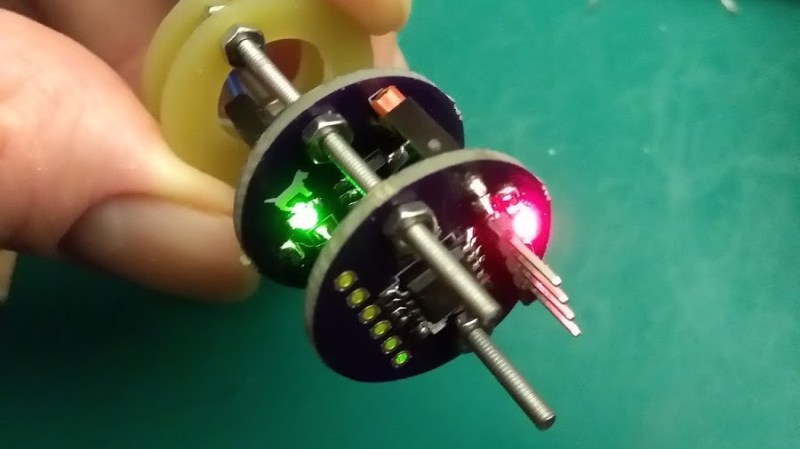Model rocketry hobbyists are familiar with the need to roll their own solutions when putting high-tech features into rockets, and a desire to include a microcontroller in a rocket while still keeping things flexible and modular is what led [concretedog] to design a system using 22 mm diameter stackable PCBs designed to easily fit inside rocket bodies. The system uses a couple of 2 mm threaded rods for robust mounting and provides an ATTiny85 microcontroller, power control, and an optional small prototyping area. Making self-contained modular sleds that fit easily into rocket bodies (or any tube with a roughly one-inch inner diameter) is much easier as a result.
The original goal was to ease the prototyping of microcontroller-driven functions like delayed ignition or altimeter triggers in small Estes rockets, but [concretedog] felt there were probably other uses for the boards as well and made the design files available on GitHub. (Thanks!)
We have seen stackable PCBs for rocketry before with the amazingly polished M3 Avionics project, but [concretedog]’s design is much more accessible to some hobbyist-level tinkering; especially since the ATTiny85 can be programmed using the Arduino IDE and the boards themselves are just an order from OSH Park away.
[via Dangerous Prototypes Blog]
















I remember dealing with a similar situation in undergrad and decided to go with a a flexible pcb that was bent enough so that the whole thing lined the curved inner surface of the rocket. This approach allowed for so much more usable area for the electronics. Though the upfront cost is a bit higher the long term gain is that assembly time and the number of BOM items required for each single unit was drastically reduced – try assembling 100 of them. Another added benefit is that the power source used could just go in the middle.without any need for a re-design.
That’s awesome! You didn’t happen to write that up, did you? (tips@hackaday.com)
It’s a neat trick to stack many layers, but I’m left wondering if a single 22mm wide PCB, without connectors, would actually have more space for useful components and be more reliable in heigh vibration and acceleration environments.
Or i2c + power using 4 bolts as bus bars ?
You would have contradictive design requirements: for better EMC you need conductors (current loops) not encompassing large areas, but mechanical supports on the contrary need to be equidistant.
This is a cool idea…I wonder if thinner board could be used to save weight. Similar issues drove the invention and use of this around the time of my birth (also for rockets, the goes-boom kind) – my Dad was a Navy engineer then, and associated with this project, so I had a few of these “tinkertoys” to play with in the ’50’s as I learned electronics. (this isn’t the only or the first, actually, this is the second generation with some made-on-board parts, the first was all discrete)
Project Tinkertoy, 1953:
https://www.youtube.com/watch?v=DhuuOWteelc
I was just about to post this same video….. this totally reminds my of Tinkertoy.
The Cray 3 also uses vertical interconnects, so this project is in good company! ????
http://bobodyne.com/web-docs/robots/cray3/index.html
If they only had LARGER soldering irons at that time….
IMO a bad example as stacking wasn’t the new thing in the Cray 3 but how they stacked things. Stacking goes back before the first Cray architecture IIRC and was used for the second Cray architecture – the CDC 6600.
Reminds me of an attempt when I was younger.
I took a saw to a pcb chopped it up into 2″ squares and then ran a load of wire to rejoin all the cut traces so the board stacked into a cube with stand offs between the layers and all the tall components soldered onto a bit of pref board on top with wires leading back to their original locations.
I’ve had almost this exact project on the to do list for a while now. I guess I can cross that one off.
Or pick up where they left off and contribute!
(Me too.)
cool idea but i think i would want more cpu power on board. like an esp32. then one could handle the processing of imu data. the tiny85 just isnt cut out for that.
Neat. Reminded me of a beefier heavier duty GEMMA designed to stack modules: https://www.adafruit.com/product/1222
We used an Ardupilot board on our rocket (granted it required much more space) and that worked nicely, together with Ardupilot telemetry modules and GPS. Aliexpress even has a variation of the ardupilot board in a case with a rocket-kinda something printed on it. They also have one with an aluminium enclosure, probably heavier but looks especially fitting.
What happened to the kid that built a guided Hobby rocket in the US many years ago it was on HAD for about 40 seconds before disappearing.
Which one of us? I was one of the “Guided” rockets (it’s stabilized dammit!!!)
Now developing instruments at NASA
https://hackaday.com/2015/10/27/youre-never-too-young-to-be-a-rocket-scientist/